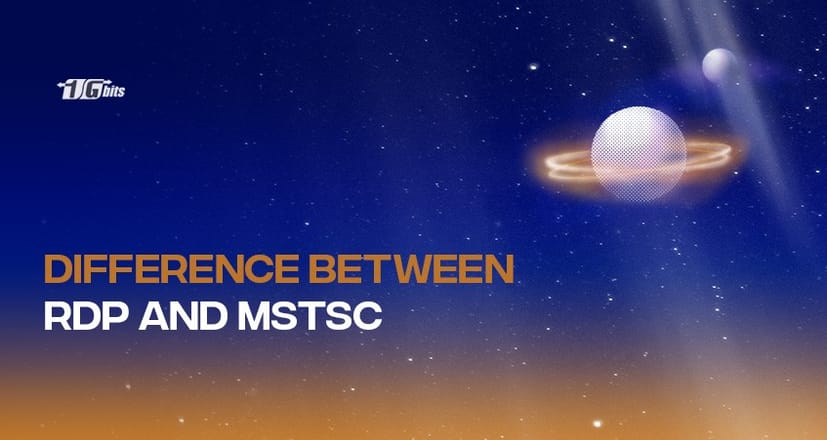In today's interconnected world, remote access to computers and servers has become an essential aspect of many businesses. This is where technologies like Remote Desktop Protocol (RDP) and Microsoft Terminal Services Client (MSTSC) come into play. In this article, we will explore the difference between MSTSC vs RDP and discuss their advantages and disadvantages, ultimately helping you decide which one is the better choice for your remote access needs.
What is Microsoft Terminal Services Client (MSTSC)?
.jpg)
Microsoft Terminal Services Client, commonly known as MSTSC or Remote Desktop Connection, is a built-in feature of the Windows operating system. MSTSC allows users to remotely connect to a computer or server that has the Remote Desktop feature enabled. It provides a graphical interface to access and control the remote machine, essentially allowing users to work on a remote system as if they were physically present in front of it.
If you are wondering How to connect clients to Terminal Services in Windows Server, check the link to learn more about it.
What are the advantages of MSTSC?
MSTSC offers several advantages that make it a popular choice for remote access.
- Firstly, it is widely supported across different versions of the Windows operating system, ensuring compatibility and ease of use.
- It also provides a seamless experience by transmitting both the video and audio output from the remote machine to the local device, enabling users to access and interact with multimedia content remotely.
- Another advantage of MSTSC is its ability to share local resources with the remote machine. This means you can transfer files, printers, and even smart card readers between the local and remote devices, enhancing productivity and convenience.
- Additionally, MSTSC supports multiple monitors, allowing users to extend their desktop across multiple screens when connected to a remote system.
What are the disadvantages of MSTSC?
While MSTSC offers numerous benefits, it does have some drawbacks.
- One limitation is that it is primarily designed for Windows-based systems. Therefore, if you need to connect to a non-Windows machine or a Linux server, MSTSC may not be the ideal choice.
- Additionally, MSTSC may not perform optimally in low-bandwidth or high-latency network environments, resulting in slower response times and degraded user experience.
What is Remote Desktop Protocol (RDP)?
.jpg)
Remote Desktop Protocol, commonly known as RDP, is a proprietary protocol developed by Microsoft for remote access to Windows-based systems. RDP enables users to connect to a remote machine over a network and interact with its graphical interface. Like MSTSC, RDP allows users to control a remote system as if they were physically present in front of it.
If you're interested in learning more about RDP, take a look at our article titled "What is a Remote Desktop Protocol" You'll discover valuable information within it.
What are the advantages of RDP?
RDP offers several advantages that make it a compelling option for remote access.
- Firstly, it provides robust security features, including encryption and authentication mechanisms, ensuring that remote connections remain secure and protected from unauthorized access.
- RDP also supports a wide range of Windows operating systems, allowing users to connect to various versions of Windows-based machines.
- Another advantage of RDP is its versatility.
- In addition to Windows machines, RDP can be used to connect to Linux servers using third-party clients. This cross-platform support makes RDP a suitable choice for businesses with heterogeneous environments.
- Furthermore, RDP is known for its efficient use of network resources, making it suitable for low-bandwidth or high-latency network connections.
What are the disadvantages of RDP?
Despite its strengths, RDP does have some limitations.
- One disadvantage is that it is primarily designed for remote access to individual computers rather than multiple users simultaneously. This means that if you require concurrent sessions or multi-user access to a remote machine, RDP may not be the most suitable solution.
- Another limitation of RDP is its dependency on the Windows operating system.
- While RDP clients are available for other platforms, the full functionality and feature set of RDP are best experienced on Windows-based systems.
What is the difference between RDP and MSTSC?
At this point, you may be wondering what sets RDP and MSTSC apart. The key difference lies in their scope and implementation.
- RDP is the underlying protocol used for remote access, while MSTSC is the client software that provides the user interface for connecting to and interacting with remote machines using RDP.
- In simple terms, RDP is the technology that enables remote access, and MSTSC is the application that allows users to utilize this technology.
- MSTSC is essentially the Windows Remote Desktop client that utilizes RDP to establish connections with remote systems.
Which one is better; MSTSC or RDP Account?
The choice between MSTSC or RDP Account depends on your specific requirements and environment.
- If you primarily work with Windows-based systems and require a user-friendly interface, MSTSC may be the better choice. Its compatibility, multimedia support, and resource sharing capabilities make it suitable for most Windows users.
- On the other hand, if you operate in a heterogeneous environment with a mix of Windows and Linux machines, and if you prioritize security and efficiency, RDP would be the preferable option. RDP's cross-platform support, robust security features, and efficient network utilization make it a versatile choice for businesses with diverse system architectures.
1Gbits offers a convenient solution for businesses looking to Buy RDP Server, providing a reliable and secure platform for remote access to servers. Check our RDP service and Buy RDP now to find the ideal solution for your remote connectivity needs- Unparalleled Security and Lightning-Fast Speeds Await You!
Final Words
In conclusion, both MSTSC vs RDP provide valuable remote access capabilities, but their suitability depends on the specific needs of your organization. For assistance with implementing and optimizing your remote access infrastructure, consider partnering with a reliable service provider like 1Gbits. 1Gbits offers a range of services, including Buy RDP Server, RDP Client for Linux, RDP clients for Ubuntu, RDP port, and RDP client software, ensuring that you have access to the right tools and solutions for your remote access requirements.
Remember, the choice between MSTSC vs RDP ultimately depends on factors such as platform compatibility, security, and network efficiency. Assess your needs and priorities, and consult with experts to make an informed decision that aligns with your business goals and objectives.
FAQs
- What is the difference between RDP and MSTSC?
- RDP is the underlying protocol for remote access, while MSTSC is the client software that utilizes RDP to establish connections.
- Is MSTSC only compatible with Windows operating systems?
- Yes, MSTSC is primarily designed for Windows-based systems.
- Can I connect to a Linux server using MSTSC?
- No, MSTSC is not compatible with Linux servers. Consider using RDP Client for Linux instead.
- What are the advantages of MSTSC?
- MSTSC offers compatibility, multimedia support, resource sharing capabilities, and a user-friendly interface.
- Are there any disadvantages of using MSTSC?
- MSTSC may not perform optimally in low-bandwidth or high-latency network environments, and it is primarily limited to Windows-based systems.
- What is RDP?
- RDP stands for Remote Desktop Protocol and is a proprietary protocol developed by Microsoft for remote access to Windows-based systems.
- Does RDP support Linux servers?
- Yes, RDP can be used to connect to Linux servers using third-party clients.
- Is RDP secure?
- Yes, RDP provides robust security features, including encryption and authentication mechanisms, to ensure secure remote connections.
- Can RDP be used in heterogeneous environments?
- Yes, RDP's cross-platform support makes it suitable for connecting to both Windows and Linux machines.
- Does RDP consume a lot of network resources?
- No, RDP is known for its efficient use of network resources, making it suitable for low-bandwidth or high-latency network connections.
- Can multiple users connect simultaneously using RDP?
- RDP is primarily designed for remote access to individual computers rather than multiple users simultaneously.
- Can I use RDP client software on platforms other than Windows?
- Yes, RDP clients are available for other platforms, but the full functionality is best experienced on Windows-based systems.
- Which is better for Windows users, MSTSC, or RDP?
- MSTSC is more suitable for Windows users due to its compatibility, multimedia support, and resource sharing capabilities.
- Which is better for heterogeneous environments, MSTSC, or RDP?
- RDP is the better choice for heterogeneous environments as it supports both Windows and Linux machines.
- Can I transfer files between local and remote devices using MSTSC or RDP?
- Yes, both MSTSC and RDP support file transfer functionality, allowing you to transfer files between local and remote devices.
- Are there any third-party RDP clients available for Linux?
- Yes, there are several third-party RDP clients available for Linux, providing RDP support for Linux users.
- What is the main purpose of an RDP server?
- The main purpose of an RDP server is to enable remote access to a computer or server, allowing users to control it remotely.
- Can I customize the RDP port for enhanced security?
- Yes, you can customize the RDP port to enhance security and prevent unauthorized access.
- Is RDP client software user-friendly?
- Yes, RDP client software provides a user-friendly interface, making it easy to connect and interact with remote machines.
- Are there any specific system requirements for using MSTSC or RDP?
- The system requirements vary depending on the operating system and version you are using. Ensure compatibility before using MSTSC or RDP.
- Can I use MSTSC or RDP to access a remote machine over the internet?
- Yes, both MSTSC and RDP can be used to access remote machines over the internet, provided the necessary network configurations are in place.
- Do I need a dedicated server to use MSTSC or RDP?
- No, you can use MSTSC or RDP to connect to remote machines that have the appropriate remote access settings enabled.
- Can I print documents from a remote machine using MSTSC or RDP?
- Yes, both MSTSC and RDP support printer redirection, allowing you to print documents from a remote machine to a local printer.
- Can I connect to a remote machine using MSTSC or RDP from a mobile device?
- Yes, there are mobile applications available that allow you to connect to remote machines using MSTSC or RDP.
- Can I use MSTSC or RDP for gaming or resource-intensive applications?
- While possible, MSTSC and RDP may not provide the optimal performance required for gaming or resource-intensive applications. Consider using dedicated gaming or high-performance solutions instead.






